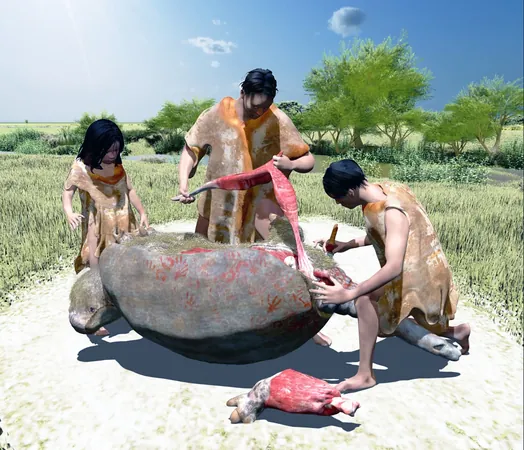
Early Humans in South America: Evidence of Survival through Giant Armadillos
2025-03-26
Author: Mei
Introduction
New research is shedding exciting light on the early migration of humans into South America, revealing that these pioneering people may have survived in part by hunting giant armadillos. This revelation is part of a broader discussion among scholars about when these early travelers first arrived, how they adapted, and the routes they followed.
The Pampas Region
The Pampas region, characterized by its vast plains, holds significant archaeological interest. Although significant attention waned during the mid-20th century, recent advancements in technology and theories are reviving investigations into the lives of early inhabitants.
Research Insights
Researchers, led by Mariano Del Papa from the National University of La Plata in Argentina, have employed cutting-edge carbon dating and ancient DNA analysis techniques to gain new insights into human-environment interactions and migration patterns. The evidence collected includes stone tools, butchered animal bones, and historical campfire sites filled with remnants of meals.
Coexistence with Megafauna
For years, scientists debated whether early humans and now-extinct megafauna, such as giant armadillos, coexisted. They sought evidence of direct contact—physical remains that show human activity or tool marks on animal bones.
Pivotal Discovery
A pivotal discovery was made along the Reconquista River, near Buenos Aires, where researchers found the fossilized remains of an extinct species known as Neosclerocalyptus, a giant armadillo-like creature. Radiocarbon dating revealed these bones to be around 21,000 years old, challenging previous estimates regarding human presence in the region.
Evidence of Butchering
Microscopic analysis of the bones uncovered telltale cut marks consistent with human butchering, indicating that early humans might have targeted these animals for their nutrient-rich meat. The location of the marks pointed to specific areas where hunters likely concentrated their efforts.
Neosclerocalyptus and its Context
Neosclerocalyptus, an enormous armored mammal related to today’s armadillos, roamed the Pampas during the Pleistocene epoch alongside saber-toothed cats and giant ground sloths. With its formidable size and tough shell, it was an appealing target for hungry hunters.
Revising the Timeline
This recent evidence suggests that humans may have occupied South America far earlier than the established timeline of 13,000 to 16,000 years ago. Similar archaeological finds across the Americas support the idea that human presence dates back perhaps over 20,000 years.
Future Research Directions
As researchers continue to explore the Pampas, the potential for uncovering additional fossils bearing human-made markings increases. These discoveries could further affirm that early human migration involved diverse landscapes, from coastal areas to inland plains.
Conclusion
Moreover, scientists believe that refining the dating methods and continuing excavations will help establish connections between these early populations and later groups, enhancing our understanding of how humans adapted to changing climates and resources in South America.
In conclusion, the findings surrounding Neosclerocalyptus not only challenge long-held perceptions about the timeline of human colonization in South America but also convey a fascinating narrative about survival, adaptability, and the intricate relationships between early humans and the formidable wildlife of their era. As researchers delve deeper into the archaeological record, they may uncover even more clues that reshape our understanding of humanity's early chapters in the Americas.



 Brasil (PT)
Brasil (PT)
 Canada (EN)
Canada (EN)
 Chile (ES)
Chile (ES)
 Česko (CS)
Česko (CS)
 대한민국 (KO)
대한민국 (KO)
 España (ES)
España (ES)
 France (FR)
France (FR)
 Hong Kong (EN)
Hong Kong (EN)
 Italia (IT)
Italia (IT)
 日本 (JA)
日本 (JA)
 Magyarország (HU)
Magyarország (HU)
 Norge (NO)
Norge (NO)
 Polska (PL)
Polska (PL)
 Schweiz (DE)
Schweiz (DE)
 Singapore (EN)
Singapore (EN)
 Sverige (SV)
Sverige (SV)
 Suomi (FI)
Suomi (FI)
 Türkiye (TR)
Türkiye (TR)
 الإمارات العربية المتحدة (AR)
الإمارات العربية المتحدة (AR)